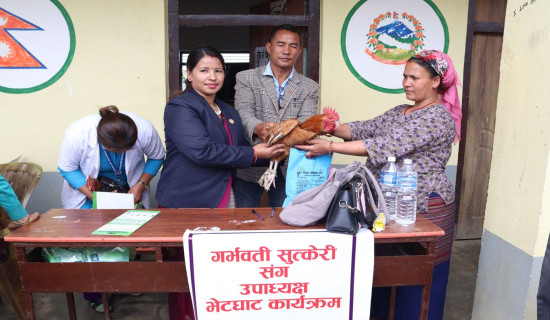- Saturday, 5 July 2025
Water shortage in BNP drives rhinos to India
By Yagya Prasad Sapkota,Bardiya, May 7: Rhinos that wandered from Bardiya National Park (BNP) and reached India’s Katarniaghat Wildlife Sanctuary in search of food and better habitat have not returned even after five months.
Their absence has led to a decline in the rhino population in BNP. Due to shrinking suitable habitat in BNP, around 20 rhinos are believed to have migrated to India.
After Indian authorities informed Nepal about the rhinos, monitoring efforts confirmed that the animals had indeed moved across the border. Conservationists said that a lack of proper habitat in Nepal forced the rhinos to seek refuge in India.
The Geruwa River, which flows through BNP, has dried up. As a result, the park is increasingly experiencing drought conditions. Rhinos need natural water bodies, rivers and grasslands to thrive. With the natural streams inside the park drying up, the park has started building artificial ponds; 182 such ponds have
been constructed so far.
The park has also excavated sediment from the Lalmatia area of the Geruwa River to create canals and bring in water. BNP Chief Conservation Officer Ashok Kumar Ram expressed hope that the rhinos will return once water is available. “We believe some rhinos may have already returned. But since this year’s rhino count was postponed, we cannot say for certain,” he said.
He added that there is still not enough water in the river, but the park has spent around Rs. 6.5 million to remove rocks, gravel and sand from Lalmatia to bring in water.
According to him, this water management effort is carried out annually. He also said that habitat restoration work is ongoing to encourage rhinos that have migrated to India to return.
The 2021 rhino census recorded 38 rhinos in BNP. Since then, three rhinos have died due to tiger attacks and natural causes. The rhino count scheduled for this year has been halted due to a lack of funds.
Park Information Officer Sarojmani Paudel said that without a recent census the current rhino population in Bardiya is unknown. However, monitoring has confirmed the migration of some rhinos to India.
Rhinos were first translocated to Bardiya from Chitwan National Park in 1986. Since then, 55 female and 45 male rhinos have been relocated to Bardiya. Among them, 36 were killed by poachers and 24 died of natural causes. Remarkably, there have been zero poaching incidents in the past 15 years.
Initially, rhinos reached the Indian border via the Khata corridor. India’s efforts to develop water ponds and grasslands for rhinos have attracted Nepali rhinos across the border.
Conservationist Ram Bahadur Shahi said rhinos migrated to India due to water scarcity in Nepal and improved artificial habitat in India. He warned that if Nepal does not improve its rhino habitats, Bardiya’s rhino population may continue to decline.
















